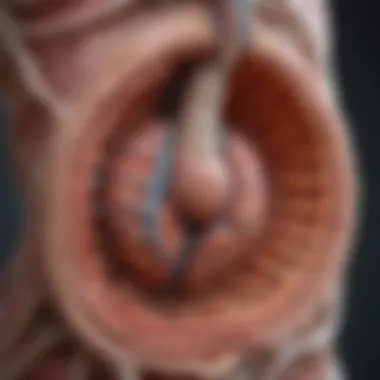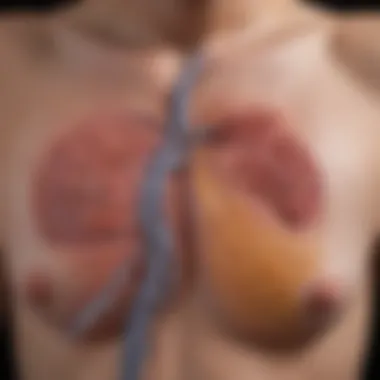Enlarged Lymph Nodes in the Stomach: Causes and Effects


Intro
Lymph nodes serve an important role in the human immune system. These small, bean-shaped structures filter lymph fluid as it travels through the lymphatic system. When lymph nodes become enlarged, particularly in the stomach area, it can indicate a variety of underlying conditions. Enlarged lymph nodes, or lymphadenopathy, might arise from infections, metastases, or systemic inflammatory diseases. Understanding the etiology of enlarged lymph nodes in the abdominal cavity requires a keen examination of potential causes, diagnostic approaches, and treatment options. This exploration will highlight the clinical significance of lymphadenopathy, shed light on innovative imaging techniques, and discuss therapeutic strategies for management.
Research Overview
Summary of Key Findings
The examination of enlarged lymph nodes in the abdominal region reveals key insights into their etiology. Several primary causes have emerged, including:
- Infections: Viral or bacterial infections often lead to lymph node enlargement, particularly in the context of an immune response. Common examples include gastrointestinal infections and viral illnesses.
- Malignancies: Tumors, both benign and malignant, can alter the lymphatic system, causing swelling. Lymphoma and metastases from other cancers, such as stomach cancer, often manifest in lymph node enlargement.
- Inflammatory Conditions: Autoimmune disorders and other inflammatory states can also cause lymphadenopathy. Conditions like sarcoidosis may result in noticeable changes in lymph node size.
In terms of diagnostic methods, contemporary imaging advancements, such as computed tomography (CT) and magnetic resonance imaging (MRI), offer non-invasive ways to assess lymph node characteristics. Furthermore, biopsy techniques provide definitive diagnosis, confirming the presence of malignancy or infection.
Importance of the Research
Delving into the causes of enlarged lymph nodes is not merely an academic exercise. It holds significant clinical relevance. A clear understanding aids in prompt diagnosis and treatment, ensuring better patient outcome. Medical professionals must be well-versed in the implications of findings related to lymphadenopathy, as timely intervention can be critical in preventing disease progression.
Methodology
Study Design
This article relies on a comprehensive literature review alongside recent studies focusing on the pathology surrounding lymphadenopathy specifically in the abdominal region. By consolidating knowledge from various sources, a holistic understanding can be achieved.
Data Collection Techniques
Data collection involved:
- Reviewing medical journals and case studies focused on lymph node pathology.
- Analyzing clinical guidelines that involve diagnostic imaging and biopsy protocols.
- Incorporating statistical data from recent research that elaborates on the incidence of enlarged lymph nodes in various conditions.
Through these methods, a detailed narrative emerges, capable of informing both clinical practices and enriching the knowledge base of students and professionals in the field.
Understanding the complexities of enlarged lymph nodes is essential for accurate diagnosis and effective treatment.
By exploring this multifaceted subject, the intention is to equip healthcare professionals and informed readers with critical insights into the implications of lymphadenopathy in the abdominal cavity.
Prelude to Enlarged Lymph Nodes
The discussion surrounding enlarged lymph nodes in the abdominal region is vital due to their implications for various health conditions. This section lays groundwork for understanding why lymphadenopathy is not just a trivial finding but often signifies underlying pathology that may require attention. Enlarged lymph nodes can indicate infections, malignancies, or even systemic diseases. Recognizing the significance of such symptoms can guide both patients and healthcare providers in decision-making processes.
Definition and Overview
Enlarged lymph nodes, known as lymphadenopathy, refer to a condition where the lymph nodes become swollen. This increase in size can stem from various etiologies, ranging from benign to serious health issues. Lymph nodes are integral components of the immune system, serving as filters for harmful substances and pathogens. Their enlargement often signifies that the body is responding to an underlying condition or anomaly. In the context of the abdominal area, lymphadenopathy may have several relevant implications, particularly concerning the digestive and immune systems. Understanding this definition is critical for both diagnosis and treatment planning.
Anatomy of Abdominal Lymph Nodes
The anatomy of lymph nodes in the abdomen is complex and diverse. These nodes are distributed throughout the abdominal cavity, primarily positioned along major blood vessels and lymphatic channels. The key clusters include the iliac, mesenteric, and para-aortic nodes. Each group has distinct roles in filtering lymphatic fluid from the specific regions they serve. The anatomy must be appreciated, as it directly relates to potential sites of infection or malignancy. Furthermore, understanding this layout can aid practitioners in their diagnostic imaging and surgical approaches.
Key Point: The location and function of abdominal lymph nodes are crucial in diagnosing various conditions, including infections, malignancies, and autoimmune disorders.
Causes of Enlarged Lymph Nodes in the Stomach
Understanding the causes of enlarged lymph nodes in the stomach is crucial. This condition can arise from various underlying pathologies. Recognizing these causes helps in tailoring appropriate diagnostic and therapeutic approaches. Distinguishing between infectious and non-infectious origins is particularly significant. It allows for more targeted treatment plans and a better understanding of patient prognosis.
Infectious Agents
Infectious agents represent a common cause of lymphadenopathy. They can lead to the activation of the lymphatic system. This activation results in swelling and enlargement of lymph nodes as they work to filter pathogens from the body.
Bacterial Infections


Bacterial infections often cause significant inflammation. A key aspect is that they may lead to localized lymph node enlargement. For example, infections like tuberculosis can result in distinct lymphadenopathy patterns. These infections gain importance as they require specific antibiotic treatments. Bacterial infections present unique challenges such as antibiotic resistance, which complicates management. Conclusively, understanding their role is vital for effective intervention.
Viral Infections
Viral infections also contribute significantly to enlarged lymph nodes. The most notable examples include HIV and Epstein-Barr virus. Their hallmark feature is the ability to occur with systemic involvement. This can be indicative of broader infections in the body. Viral causes are popular in literature due to their complex nature and varied presentation. The challenges include a lack of targeted antiviral therapy for many viral infections, creating a need for further research.
Parasitic Infections
Parasitic infections such as toxoplasmosis can also cause lymph node enlargement. These infections might be severe in immunocompromised individuals. A unique feature of parasitic infections is their often chronic nature, leading to ongoing inflammation. Recognizing them is beneficial, as they may require a different treatment approach compared to bacterial or viral infections. Awareness of these infections ensures that lymphadenopathy is managed comprehensively, improving patient outcomes.
Non-Infectious Cause
Non-infectious causes also play a significant role in causing enlarged lymph nodes. They can be a reflection of various systemic conditions, informing the clinician’s understanding of underlying issues.
Inflammatory Diseases
Inflammatory diseases such as sarcoidosis can lead to notable lymphadenopathy. They are characterized by a non-specific inflammatory response. These diseases are crucial for this article due to their multifactorial nature and associations with other health issues. Recognizing inflammatory diseases can provide valuable insights into a patient’s overall health and guide further investigations.
Malignancies
Malignancies, including lymphoma and metastatic tumors, represent serious causes of lymph node enlargement. Their significance lies in the potential for aggressive disease progressions. The challenge here is early detection, influencing survival rates. Thus, understanding malignancies within this context is essential for practitioners. This prevents misdiagnoses and ensures timely interventions.
Autoimmune Disorders
Autoimmune disorders such as systemic lupus erythematosus may also manifest as lymphadenopathy. These disorders lead to inflammation as the immune system attacks the body’s own tissues. Their inclusion in this article is important, as they contribute to the complexity of diagnosis. Patients with autoimmune conditions often present with multi-systemic symptoms, complicating the evaluation. This highlights the need for a comprehensive approach in understanding and managing enlarged lymph nodes.
Clinical Presentation
The clinical presentation of enlarged lymph nodes in the stomach is a critical area of focus in understanding the underlying causes and implications. This section discusses the symptoms and signs that accompany lymphadenopathy in the abdominal region, providing essential information for both diagnosis and management. Identifying these symptoms early can significantly influence treatment outcomes and patient prognosis.
Symptoms and Signs
Localized Symptoms
Localized symptoms refer to signs that are confined to a specific area, often correlating to the presence of enlarged lymph nodes in a particular region of the abdomen. Key characteristics of localized symptoms may include tenderness or pain in the stomach area, which can help differentiate between various underlying conditions.
The significance of localized symptoms in this context cannot be overstated. They offer direct insight into the bodily response to pathology, creating a pathway for clinicians to prioritize certain diagnostic tests. For example, if a patient presents with pain that is distinct and localized, it might prompt further investigation into potential infections or malignancies in that exact region.
However, it is crucial to keep in mind that localized symptoms can be influenced by other factors such as referred pain from adjacent organs or structures. Therefore, while they are a beneficial aspect of the clinical presentation, they must be interpreted within a broader clinical context.
Systemic Symptoms
Systemic symptoms encompass a broader range of signs that may indicate a widespread effect of the underlying pathology, affecting the entire body rather than a specific location. Common systemic symptoms include fever, weight loss, and fatigue, which often accompany conditions like infections or malignancies. These signs are crucial as they suggest a more generalized reaction of the immune system to an insult.
The key characteristic of systemic symptoms lies in their ability to signal serious underlying conditions that require immediate attention. For instance, a combination of fever and significant weight loss in conjunction with enlarged lymph nodes in the stomach should raise concerns about possible malignancies or severe infections.
The unique feature of systemic symptoms is their potential to alert healthcare providers to the severity of the condition. However, one disadvantage includes the relatively nonspecific nature of these symptoms, which could arise from numerous conditions not related to lymphadenopathy. Therefore, while they are essential indicators, they necessitate further investigation to pinpoint the exact underlying cause.
Physical Examination Findings
Physical examination findings are integral to the clinical assessment of a patient suspected to have enlarged lymph nodes in the stomach. This examination often includes palpation of the abdomen to assess the size and consistency of lymph nodes. Observing whether there is associated tenderness or any fluctuation in size provides foundational data to support a diagnosis.
Physical findings also serve to contextualize the subjective complaints reported by patients. For instance, if a patient indicates discomfort in a specific location, the examiner may correlate this with palpable lymphadenopathy in that area. This direct relationship reinforces the importance of physical examination as an initial step in formulating a diagnostic pathway.
In summary, understanding the clinical presentation of enlarged lymph nodes in the stomach is vital. Symptoms can be localized or systemic and hold distinct value in the diagnostic process. Likewise, physical examination findings are essential for corroborating patient reports and guiding further investigative efforts.
Diagnostic Evaluation
Diagnostic evaluation is critical in understanding enlarged lymph nodes in the stomach. It helps identify the underlying causes of lymphadenopathy. This step is valuable because an accurate diagnosis influences treatment plans and patient outcomes. Furthermore, timely diagnostic intervention can prevent complications and allow for better prognosis.


Imaging Techniques
Imaging techniques are essential in this context. They provide visual insight into the lymph nodes and surrounding structures. This aids in determining the size, shape, and presence of any abnormalities.
Ultrasound
Ultrasound is a non-invasive imaging technique. It uses sound waves to produce images of internal structures. One key characteristic of ultrasound is its safety, as it does not involve radiation. This makes it a preferred initial diagnostic tool for evaluating abdominal lymph nodes. The unique feature of ultrasound is its ability to guide fine-needle aspirations for biopsy. However, its limitations include operator dependency and decreased visualization of deep structures.
CT Scans
CT scans offer detailed cross-sectional images of the abdomen. They are effective in providing a comprehensive view of enlarged lymph nodes. A major advantage of CT scans is their speed and the extensive details they provide. This is especially important for assessing lymph node enlargement in relation to other anatomical structures. On the other hand, the radiation exposure is a drawback, raising concerns for repeated use in certain patient populations.
MRIs
MRI provides superior soft tissue contrast compared to CT scans. This characteristic makes it beneficial for visualizing the lymphatic system. Most importantly, MRI does not use ionizing radiation, making it safer for patients in need of multiple assessments. The unique aspect of MRI lies in its ability to provide detailed images of both lymph nodes and surrounding visceral organs. However, MRIs are less commonly used due to their higher cost and longer scan times.
Laboratory Investigations
Laboratory investigations complement imaging studies. They provide valuable biochemical and cellular information.
Blood Tests
Blood tests are crucial for evaluating systemic involvement in cases of lymphadenopathy. A significant aspect of blood tests is their ability to detect abnormalities, such as elevated white blood cell counts or specific markers of inflammation. This makes them a beneficial preliminary approach in assessing the patient's health status. However, blood tests alone do not determine the cause of enlarged lymph nodes, which is a limitation.
Biopsy Procedures
Biopsy procedures offer definitive diagnosis of suspicious lymph nodes. They involve extracting tissue samples for microscopic examination. One key characteristic of biopsies is their direct assessment of cellular characteristics. This makes them essential in determining malignancy versus benign causes. A unique feature is the ability to utilize different methods such as fine-needle aspiration or core needle biopsies. The disadvantage is that biopsies can be invasive and carry some risk of complications.
Diagnostic evaluation encompasses both imaging and laboratory studies, forming a multifaceted approach to understanding lymphadenopathy.
Management and Treatment
The management and treatment of enlarged lymph nodes in the stomach is critical for addressing the underlying causes and preventing further complications. Effective management depends on precise diagnosis and targeted therapy based on the specific etiology. In many cases, this involves a multidisciplinary approach. Understanding the therapeutic options can not only alleviate symptoms but also enhance the patient's overall prognosis. The treatment options can be broadly classified into those aimed at infectious causes and those tailored for non-infectious causes.
Treatment of Infectious Causes
Antibiotic Therapy
Antibiotic therapy plays a vital role in managing infections that lead to enlarged lymph nodes. This treatment targets bacterial pathogens causing lymphadenopathy. A significant characteristic of antibiotic therapy is its ability to be tailored based on the specific bacteria identified through lab tests. This targeted approach makes antibiotics a popular choice within infectious disease management. One key advantage is that antibiotics often work quickly, reducing both the size of the lymph nodes and the infection itself. However, some disadvantages include potential side effects and the emergence of drug-resistant strains, which complicates the treatment landscape.
Antiviral Treatments
Antiviral treatments are essential for managing viral infections that can cause enlarged lymph nodes. These treatments inhibit viral replication, directly addressing the cause of the lymphadenopathy. A prominent characteristic of antiviral treatments is their focused mechanism on stopping viral activity without affecting healthy cells. This specificity makes antivirals beneficial in treating conditions like Epstein-Barr virus and cytomegalovirus, which are known to impact lymphatic tissues. However, the downside is that antivirals may only reduce symptoms without eliminating the virus from the body completely, necessitating ongoing management.
Management of Non-Infectious Causes
Corticosteroids
Corticosteroids are frequently used to manage non-infectious causes of lymph node enlargement, particularly inflammatory diseases. The primary mechanism of corticosteroids is their potent anti-inflammatory effect, which helps to control swelling and pain associated with lymphadenopathy. A key feature of corticosteroids is their ability to provide rapid relief of symptoms. This is particularly advantageous in autoimmune disorders where lymph nodes may become enlarged due to an exaggerated immune response. However, long-term use of corticosteroids can lead to side effects, including weakened immune response and metabolic changes, which needs careful consideration when developing a treatment plan.
Chemotherapy
Chemotherapy is essential for treating malignancies that cause enlarged lymph nodes. This approach targets rapidly dividing cancer cells, making it a cornerstone in the management of lymphomas and other cancers affecting lymphatic systems. A significant feature of chemotherapy is its potential to achieve remission in cancer patients, thus addressing the root cause of lymph node enlargement. However, the disadvantages include a range of side effects such as nausea and immune suppression, which necessitate comprehensive support measures during treatment.
Understanding the appropriate management strategies for enlarged lymph nodes is crucial for effective patient care. A well-informed healthcare team can enhance treatment outcomes and patient satisfaction.
Prognostic Considerations
Prognostic considerations play a crucial role in the understanding of enlarged lymph nodes in the stomach. The presence of lymphadenopathy often signals underlying health issues, making it essential to evaluate various factors that may impact patient outcomes. Assessing prognosis helps in tailoring treatment choices and setting appropriate expectations for recovery. This section provides insights into aspects fundamental for predicting outcomes in affected individuals, shedding light on how personalized approaches can enhance management strategies.


Factors Affecting Prognosis
Underlying Diseases
Underlying diseases significantly influence the prognosis of patients with enlarged lymph nodes. Conditions like infections, cancer, or autoimmune disorders can alter how lymph nodes react, both in terms of size and response to treatment. One key characteristic of underlying diseases is their potential to complicate diagnosis and management. As such, these diseases must be considered carefully. For instance, a patient with lymphoma may have a different prognosis compared to someone with a benign infection. This difference is essential when assessing treatment options and possible outcomes.
The unique feature of underlying diseases is their variability; each condition may present distinct symptoms or complications that impact the prognosis. For example, patients with chronic inflammatory diseases may experience persistent enlargement, ultimately leading to fibrosis of lymph nodes, which can hinder immune function and complicate treatment. Hence, understanding the specific underlying disease affects clinical decisions made by healthcare professionals.
Response to Treatment
Response to treatment is another critical factor affecting prognosis for those with enlarged lymph nodes. This aspect looks at how well the patient reacts to the prescribed therapies, whether these are for infections, malignancies, or other underlying conditions. The key characteristic of response to treatment is its predictability; the sooner a successful intervention is identified, the better the long-term outcome. In many scenarios, timely treatment can lead to significant reductions in lymph node size and improve overall health.
The unique feature of evaluating treatment response is the ability to tailor ongoing management strategies based on initial outcomes. For instance, a patient responding poorly to chemotherapy may require alternative approaches or a more aggressive treatment regimen. This adaptability is advantageous as it allows healthcare providers to make data-driven decisions. However, poor response to treatment may lead to prolonged treatment plans or escalation of care, which can add emotional and financial burden to patients.
Long-term Outcomes
Long-term outcomes related to enlarged lymph nodes can vary significantly based on multiple factors, such as the aggressiveness of underlying diseases, the effectiveness of treatments instituted, and the patient’s overall health status. Regular follow-ups, combined with ongoing monitoring through imaging and clinical evaluations, provide crucial information in managing patients effectively. Understanding these outcomes allows healthcare professionals to strategize personalized care plans, facilitating better patient engagement in their treatment pathways.
Overall, prognostic considerations encapsulate both the clinical complexities and personal histories that interlink individual patient journeys, emphasizing the importance of personalized medicine.
Recent Advances in Research
Recent research has brought important insights into enlarged lymph nodes within the stomach region. Understanding how lymph nodes respond to various stimuli is crucial for managing related conditions effectively. The focus on recent developments emphasizes the significance of innovative treatment and diagnostic strategies, contributing to better patient outcomes. In this section, we will explore novel therapeutic approaches and emerging diagnostic techniques, detailing their implications for clinicians and researchers.
Novel Therapeutic Approaches
Targeted Therapies
Targeted therapies represent a significant advancement in treating enlarged lymph nodes, especially in cancer-related contexts. These therapies aim at specific molecular targets associated with the abnormal growth of lymphatic tissues. The key characteristic of targeted therapies is their ability to selectively attack cancer cells while sparing normal cells, which can lead to reduced side effects.
This approach is beneficial because it can enhance treatment efficacy and improve the quality of life for patients. The unique feature of targeted therapies is their reliance on genetic and molecular profiling to identify the most appropriate treatment plan. However, some disadvantages include the limited availability of biomarkers and potential resistance from certain tumors that may develop over time.
Immunotherapy
Immunotherapy is another innovative strategy gaining traction. It harnesses the body's immune system to fight against diseases associated with lymph node enlargement, particularly malignancies. A notable characteristic of immunotherapy is its potential to create long-lasting immune memory, which can lead to durable responses in some patients. This aspect is particularly appealing in the management of metastatic diseases.
Immunotherapy is popular because it offers a different mechanism of action compared to conventional treatments such as chemotherapy. This unique feature can result in improved outcomes for patients with specific cancer types. However, the drawbacks include side effects related to immune activation and the limited effectiveness in certain individuals.
Emerging Diagnostic Techniques
Liquid Biopsy
Liquid biopsy has emerged as a powerful non-invasive diagnostic tool. It analyzes circulating tumor cells, cell-free DNA, and other components in the bloodstream to provide insights into the presence of malignancies affecting lymph nodes. The key characteristic of liquid biopsy is its ability to gather information without the need for invasive procedures, making it a convenient choice for both patients and healthcare providers.
The primary advantage of liquid biopsy lies in its potential for early detection and real-time monitoring of treatment responses. However, limitations include the need for further validation and standardization, as well as variations in sensitivity depending on the type of cancer.
Genomic Profiling
Genomic profiling is a sophisticated technique that identifies genetic abnormalities within tumors in enlarged lymph nodes. This process helps in determining the most effective therapeutic options tailored to individual patients. A key characteristic of genomic profiling is its capacity to reveal actionable mutations that could otherwise remain undetected with traditional diagnostic tools.
Its contribution to personalized medicine is significant, aiding in the selection of targeted therapies that maximize efficacy. However, genomic profiling also presents challenges, including the complexity of genetic data interpretation and high costs associated with comprehensive testing.
Closure
The conclusion serves as a crucial component of this article, encapsulating the key insights drawn from the exploration of enlarged lymph nodes in the stomach. Understanding the etiology and implications of lymphadenopathy in the abdominal cavity provides an essential framework for practitioners and informed readers. The main benefit of such knowledge lies in the potential to improve diagnostic accuracy and treatment outcomes.
Summarizing Key Insights
This article delves into the multifaceted aspects of enlarged lymph nodes, including their anatomical relevance, causes—both infectious and non-infectious, and clinical presentations. The diagnostic evaluation emphasized imaging and laboratory methods, ensuring that readers grasp the importance of thorough investigations. Furthermore, management strategies highlight treatment approaches, particularly emphasizing the distinct needs of patients based on their underlying conditions. Overall, these insights illuminate the intricate relationship between lymphatic health and broader systemic pathologies. As practitioners sift through the complexities of each case, a comprehensive understanding as provided herein will aid in making informed clinical decisions.
Future Directions in Research
Looking ahead, future research into enlarged lymph nodes in the stomach should focus on several critical areas. First, a deeper investigation into novel diagnostic techniques, such as liquid biopsy and genomic profiling, may reveal previously unseen biomarkers of disease. These advances can enhance the precision of diagnosis and enable personalized treatment plans.
Moreover, targeted therapies and immunotherapy emerge as promising avenues for treating lymphadenopathy linked to malignancies and autoimmune disorders. Investigating the long-term effects and efficacy of these interventions will be vital. Collaborative studies across institutions can foster innovation and drive research forward. Ultimately, ongoing exploration of these dimensions will not only enrich the existing knowledge but also enhance the management of conditions associated with enlarged lymph nodes.



